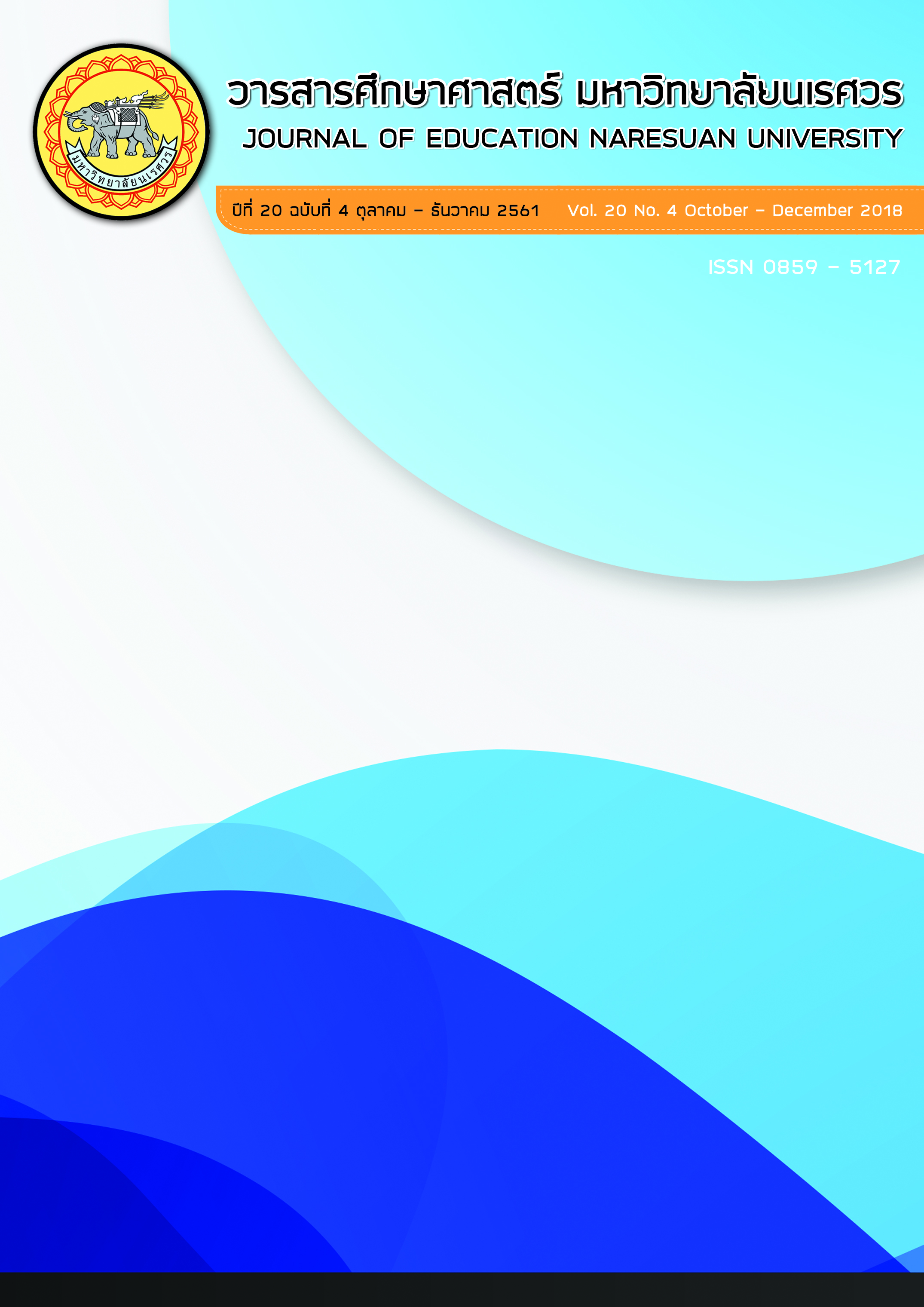การพัฒนาแบบประเมินการจัดการเรียนรู้อย่างมีความสุขของนิสิตครูในศตวรรษที่ 21; THE RESEARCH AND DEVELOPMENT OF THE HAPPINESS LEARNING MANAGEMENT ASSESSMENT INSTRUMENTS OF STUDENT TEACHERS IN THE 21st CENTURY
Main Article Content
Abstract
การวิจัยในครั้งนี้มีวัตถุประสงค์เพื่อพัฒนาแบบประเมินการจัดการเรียนรู้อย่างมีความสุขของนิสิตครูในศตวรรษที่ 21 กลุ่มตัวอย่าง ได้แก่ นิสิต/นักศึกษาครู คณะศึกษาศาสตร์/ครุศาสตร์ ในมหาวิทยาลัยของรัฐ จังหวัดพิษณุโลก ปีการศึกษา 2559 ชั้นปี 5 จำนวน 452 คน ดำเนินการวิจัยโดยสร้างแบบประเมินการจัดการเรียนรู้อย่างมีความสุขของนิสิตครูในศตวรรษที่ 21 แล้วตรวจสอบคุณภาพด้านอำนาจจำแนก ความตรงเชิงโครงสร้าง และความเที่ยง วิเคราะห์ข้อมูลโดยสถิติเชิงบรรยาย และการวิเคราะห์องค์ประกอบเชิงยืนยันอันดับที่สอง ผลการวิจัยพบว่า แบบประเมินการจัดการเรียนรู้อย่างมีความสุขของนิสิตครูในศตวรรษที่ 21 ที่พัฒนาขึ้นมีลักษณะเป็นแบบมาตราส่วนประมาณค่า 5 ระดับ จำแนกออกเป็น 5 องค์ประกอบ ได้แก่ องค์ประกอบที่ 1 ด้านผู้เรียน จำนวน 15 ข้อ องค์ประกอบที่ 2 ด้านครูและการจัดกิจกรรมการเรียนรู้ จำนวน 19 ข้อ องค์ประกอบที่ 3 ด้านบรรยากาศและแหล่งเรียนรู้ จำนวน 9 ข้อ องค์ประกอบที่ 4 ด้านบทเรียนและสื่อประกอบการเรียน จำนวน 12 ข้อ และองค์ประกอบที่ 5 ด้านการวัดและประเมินผล จำนวน 9 ข้อ รวม 64 ข้อ มีค่าอำนาจจำแนก (Discrimination: r) อย่างมีนัยสำคัญทางสถิติที่ระดับ .05 และมีความตรงเชิงโครงสร้าง (Construct Validity) ครบทุกข้อ แบบประเมินมีค่าความเที่ยง (Reliability) จำแนกตามองค์ประกอบ มีค่า ระหว่าง .910, .941, .937, .960 และ .870 ตามลำดับซึ่งมีค่าอยู่ในระดับสูงถึงสูงมาก
THE RESEARCH AND DEVELOPMENT OF THE HAPPINESS LEARNING MANAGEMENT ASSESSMENT INSTRUMENTS OF STUDENT TEACHERS IN THE 21st CENTURY
The evaluation development of the happy learning of teacher students the 21st century was aimed. The samples were the 5 years of 452 teacher students, faculty of education in Government University in Phitsanulok, academic year of 2016. The evaluation of the happy learning of teacher students the 21st century was created. The discrimination quality, construct validity and reliability were then verified. The data were analyzed by descriptive statistics and second confirmatory factor analysis. It were found that, the created of evaluation of the happy learning of teacher students the 21st century are 5 level rating scale and 5 components of
1) 15 items of happiness learning of student component, 2) 19 items characteristic and teacher management process component, 3) 9 items of atmosphere and resources for happiness learning of student component, 4) 12 items of lesson design units and happiness learning media component, and 5) 9 items of measurement and evaluation component. The discrimination (r) is statistically significant at the 0.05 and all of 64 items are construct validity. The reliabilities of the assessments ranged by components are 0.910, 0.941, 0.937, 0.960 and 0.870, respectively, which are in the high to very high score.
Article Details
The owner of the article does not copy or violate any of its copyright. If any copyright infringement occurs or prosecution, in any case, the Editorial Board is not involved in all the rights to the owner of the article to be performed.
References
Chatkhup, S., et al. (2001). Pleasant learning: Neurotransmitters with happily learning. Bangkok: Sky book. (in Thai)
Chinnawong, W. (2001). Integrated learning management. Academic journal, 4(10), 27-33. (in Thai)
Jirawongrungruang, P. (1999). Pleasant learning. Techno- Tab Kaew Academic journal, 2, 28-32. (in Thai)
McKinsey. (2007). McKinsey report on education. Retrieved March, 1, 2014, from http://www.mckinsey.com
Ministry of Education. (2003). Education program in early childhood education B.E. 2546. Bangkok: Kurusapa Printing Ladphrao. (in Thai)
Office of the Education Council. (2005). The national educational standards. Bangkok: Sahy Block & Karnpim. (In Thai)
Office of the National Education Commission. (1997). “Learning reform with Master teachers” student-centered learning reform “teaching through constructing knowledge and learning happily”. Bangkok: Parbpim. (in Thai)
Office of the National Education Commission. (2001). Happily learning theory. Bangkok: Wattanapanich. (In Thai)
Panich, W. (2012). Way of learning for students in the 21st century. Bangkok: Sodsri-Saridwongso Foundation. (in Thai)
Pornsima, D. (2011). The development of teaching professional. Matichon. Retrieved from https://www.matichon.co.th/matichon/view_news.php?newsid=01edu20311251§ionid=0107&day=2008-12-31 (in Thai)
Samkoses, W., et al. (2010). Suggestions of suitable alternative education system for the wellness of Thai people. Bangkok: Parbpim. (in Thai)

